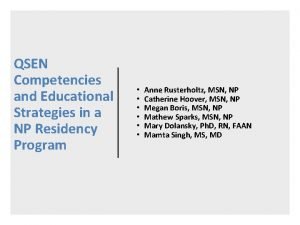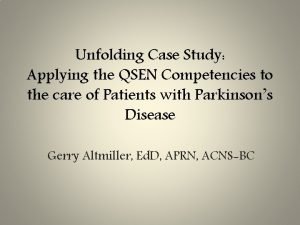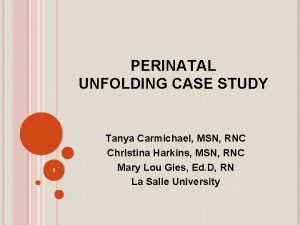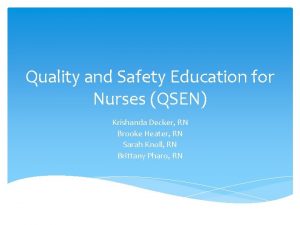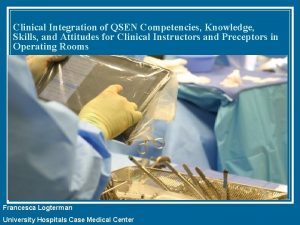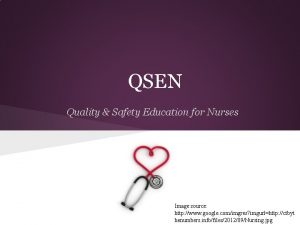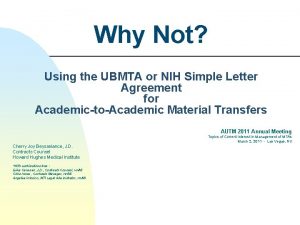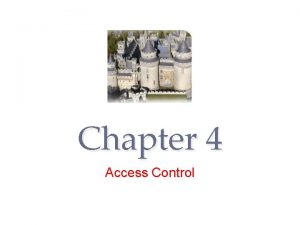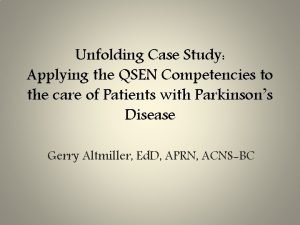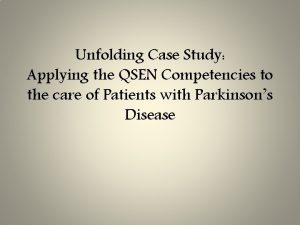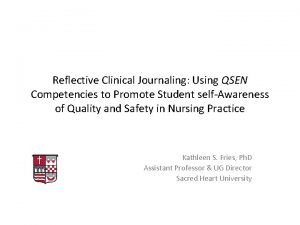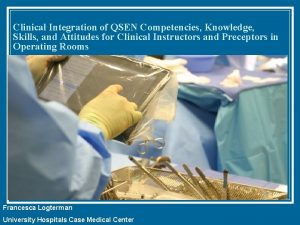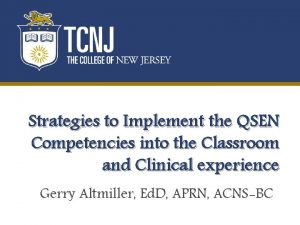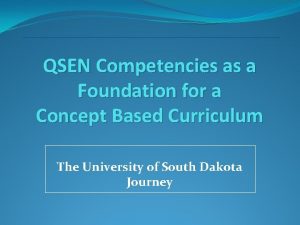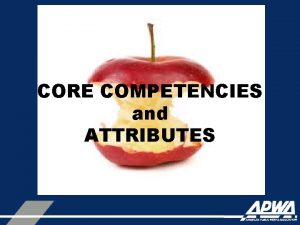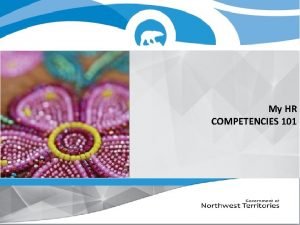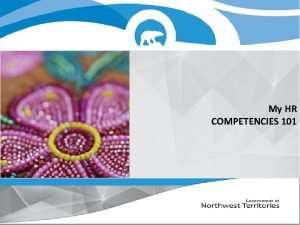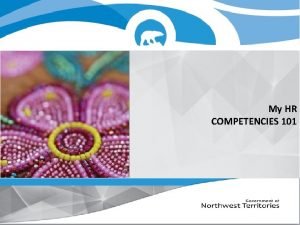Implementing the QSEN Competencies The University of Pennsylvania





























- Slides: 29

Implementing the QSEN Competencies: The University of Pennsylvania Health System Journey Kathleen Burke, Ph. D, RN, CENP, FAAN Corporate Director, Nursing Professional Development and Innovation University of Pennsylvania Health System Assistant Dean, Clinical Nurse Learning School of Nursing Senior Fellow, Leonard Davis Institute of Health Economics University of Pennsylvania May 31, 2017

University of Pennsylvania Health System Penn Medicine 2

3

4

5

Nursing Residency At Penn Medicine 2011

Penn Medicine Nursing Council for the Advancement of Professional Practice (CAPP) 2013 CAPP Competency Steering Committee On-going Competency Initial Competency Clinical Excellence Awards Professional Practice Competencies Position Descriptions Domains of Practice Taskforce Performance Appraisals Clinical Advancement 7

Why is this Important? Position Descriptions Care Delivery Model Professional Practice Model Evaluations • Self • Peer Competency Domains Continuing Education Clinical Advancement Clinical Recognition Orientation and Residency Program Quality Care and Outcomes Competency Program • Initial • On-going 8

Nurse Competency Program 9

Development of Competency Domains w Penn Medicine Council for the Advancement of Professional Practice (CAPP) w Developed 8 competency domains w 186 knowledge, skills, attitudes (KSAs) w Evidence – based • Landmark reports • High quality evidence • Recommendations of professional organizations • Clinical expertise • An extensive literature review • Professional Consultation – Jane Barnsteiner Ph. D, RN, FAAN – Donna Wright MS, RN 10

8 New Evidence Based Professional Practice Competencies Clinical Judgment and Decision Making Nurse Patient/Family Relationship Clinical Leadership Clinical Scholarship Teamwork Information and Technology Continuous Quality Improvement Safety Leadership* Evidence Based Practice & Research Professionalism* Person and Family Centered Care 11

Penn Nursing Competency Domains & Definitions Person and Family Centered Care: Recognize the patient or designee as the source of control and full partner in providing compassionate and coordinated care based on respect for patient’s preferences, values, and needs. Teamwork: Effectively engages in the process of cooperation, coordination, and collaboration in an effort to provide for safe, quality outcomes for patients within an inter and intra-professional teams, including virtual teams. Evidence-Based Practice and Research: Evaluates and integrates best current evidence with clinical expertise and patient/family preferences and values for delivery of optimal health care and system effectiveness. Informatics/Technology: Utilizes appropriate information and technology to communicate, manage knowledge, mitigate error, and support decision making across the continuum. 12

Penn Nursing Competency Domains (con’t) Continuous Quality Improvement (CQI): Utilizes data and QI methods to identify potential and actual problems and opportunities to provide care that is safe, timely, efficient, effective and equitable. Safety: Minimizes risk of harm to patients, families, providers and self through system effectiveness and individual performance. Professionalism: Demonstrates a commitment to the nursing profession through life-long learning, adherence to the ANA code of Ethics for Nurses, participation in a professional organization, and advancing community outreach. Leadership: Effectively collaborates and applies innovative, systems thinking to engage in systematic, evidence-based problem-solving and decision making to promote effective changes within a complex care delivery system supporting the vision of Penn Medicine. 13

Creating an Evidence-Based Progression for Clinical Advancement Programs Burke, Kathleen G. Ph. D, RN, CENP, FAAN; Johnson, Tonya DNP, RN, CCRN-K, NEA-BC; Sites, Christine MSN, RN; Barnsteiner, Jane Ph. D, RN, FAAN American Journal of Nursing: May 2017 - Volume 117 - Issue 5 - p 22– 35 14

Summary of KSAs in the Clinical Ladder Post-study Competency Domain CN I Patient and Family Centered Care Safety Professionalism Leadership Teamwork Technology and Informatics Continuous Quality Improvement Evidenced Based Practice and Research Total CN II 20 17 16 9 8 7 4 3 84 CN III 8 3 7 5 6 10 5 3 47 Total # of KSA CN IV 3 6 8 8 7 4 5 5 46 0 0 1 0 4 4 9 31 26 31 22 22 21 18 15 186 15

Benefits of Applying the Empirical Evidence to Practice w As a result of the evidence generated from the Delphi study, Penn Medicine has the unique opportunity to apply this evidence to: • Drive quality and clinical outcomes as it supports the Penn Medicine Blueprint for Quality and Safety • Clearly define role expectations through redesign of the performance appraisals • Enhance accountability in our clinical advancement program • Recognize and promote the contemporary practice of our nurses • Elevate professional nursing practice 16

Professional Practice Competency Relationship Position Descriptions • 8 competency domains are essential across 4 levels of contemporary practice Clinical Advancement • Progressive movement through the 8 competency domains across 4 distinct levels Portfolio Competency Domains Performance Appraisals • Reflect the scope and proficiency of all 8 domains at each level Portfolio 17

Prelaunch Task List Task Ownership Final revision of position descriptions and approval by each entity CNO Taskforce/Human Resources Development of performance evaluation tool and approval by each entity CNO Taskforce/Human Resources Development of the portfolio tool Taskforce Develop Communication and Education Plan Taskforce/Nursing Education Approval and alignment of policy revisions CNOs 18

Phase I Taskforce Outcomes w Revised position descriptions w Revised performance appraisals forms and process w Began Development of Educational toolbox • Develop examples of how to meet KSA for each Competency Domain – In each clinical level - Complete – In various environments – In process w Began revision of behavioral interview tool based on 8 professional practice domains 19

2016 Penn Medicine Nursing Learning Needs Assessment Survey Conducted: April 25 -May 20, 2016

Penn Medicine Nursing Learning Needs Assessment Nursing Domains of Practice Ranking Domain Response Count 1 Continuous Quality Improvement Process 1917 2 Evidence-Based Practice Research 1850 3 Person and Family Centered Care 1812 4 Safety 1781 5 Leadership 1776 6 Professionalism 1686 7 Teamwork 1589 8 Technology / Informatics 1370 21

Phase 2 Education and Implementation 22

Evaluation of Implementation 23

DRAFT Timeline: Integration of Professional Practice Competencies Clinical Advancement Vet through CNO Council Finalize position Position Descriptions descriptions(PD) CNO’s develop letter Performance Evaluations Communication and Education Spring 2017 Begin Communi cation about New Advance ment Program Fall 2017 July 2017 Role out position descriptions (PD) and Last Advancement competency expectations for each level using current program Jan 2018 PDs reviewed and signed. Sign letter of intent for appropriate clinical level April -May-June 2018 Begin Performance Evaluations with new tool July-Sept 2018 Oct. 2018 Advancement announced by Committees 1. Acceptance of New Advancement Applications. 2. Committess begin to review Use current evaluation tool Feb. 27, 2017 24

w CHANGE is HARD! w Major Paradigm shift w Definition of a competency? w All about Quality and Safety !! w QSEN competencies provide a great framework for practice to build upon w Front line nurses really resonated with the 8 competencies- “They reflect our practice” 25

26

27

Further Information contact: Kathleen. burke@uphs. upenn. edu 28

“The IOM report did not simply suggest that nurses contribute to changing our healthcare system it warned that change would not succeed unless nurses helped shape and lead it. ” Hassmiller, S. (2015) 29
 Qsen teamwork and collaboration
Qsen teamwork and collaboration Qsen competencies examples
Qsen competencies examples Qsen competencies
Qsen competencies Qsen phases
Qsen phases Qsen competencies
Qsen competencies Differential diagnosis for atopic dermatitis
Differential diagnosis for atopic dermatitis California university of pennsylvania global online
California university of pennsylvania global online Qsen teamwork and collaboration
Qsen teamwork and collaboration Qsen competency safety
Qsen competency safety Bubblehep
Bubblehep Qsen
Qsen Quality and safety education for nurses (qsen)
Quality and safety education for nurses (qsen) Qsen simulation rubric
Qsen simulation rubric Quality and safety education for nurses
Quality and safety education for nurses Retail management notes doc
Retail management notes doc Ubmta signatories
Ubmta signatories Planning and implementing crm projects
Planning and implementing crm projects Implementing strategies management and operations issues
Implementing strategies management and operations issues Access rights definition
Access rights definition Brand hierarchy
Brand hierarchy Designing and implementing branding strategies
Designing and implementing branding strategies Nfpa 1600
Nfpa 1600 Challenges of implementing predictive analytics
Challenges of implementing predictive analytics Chapter 7 strategic management
Chapter 7 strategic management Problems in implementing portfolio management
Problems in implementing portfolio management Nfpa 1600
Nfpa 1600 Brand hierarchy levels
Brand hierarchy levels Stateful firewall
Stateful firewall Implementing organizational change spector
Implementing organizational change spector Tripod of pricing
Tripod of pricing

